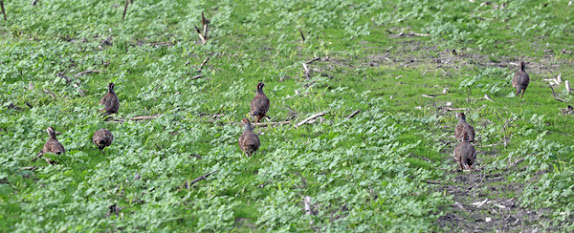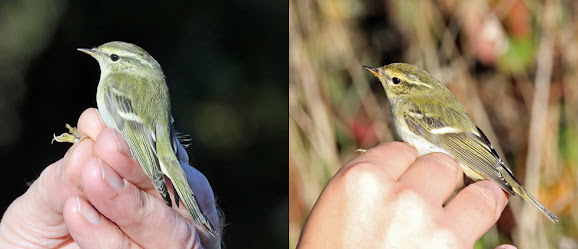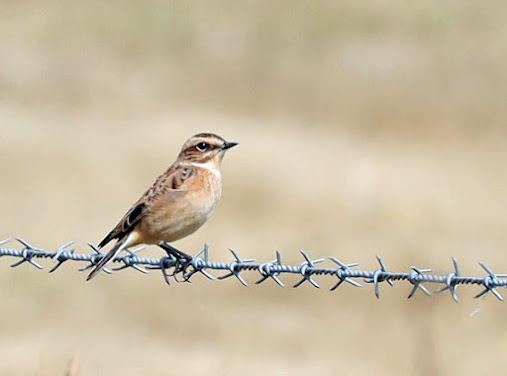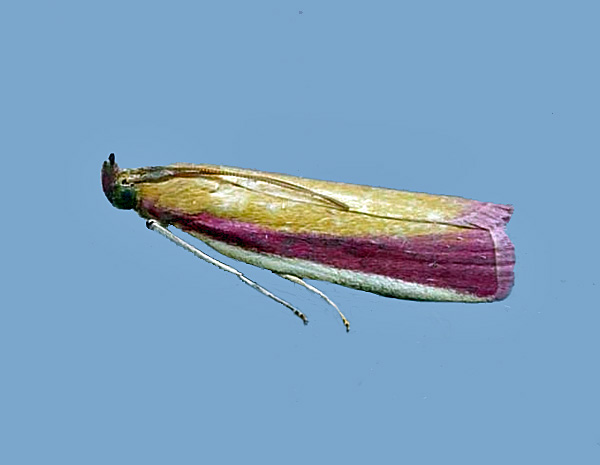Evie my 12yr old granddaughter has been volunteering along with me at Arne through the summer holidays and on the 1st we were doing reptile work placing out new covers and removing old ones etc. During the morning we had a view of one of the White-tailed Eagles and Stewart suggested we had lunch at the old Clay pit lake and as we were munching lunch Terry called Osprey and there it was crossing in front of us and it perched in a dead tree across the lake and stayed until we finished our lunch when it flew around and headed out over the Wareham Channel. Not often you can say you had lunch with an Osprey.
 |
| Osprey Arne © Nick Hull |
Getting back into the swing of birding and our first highlight was 3 Curlew Sandpiper in Brand's Bay thanks to a call from @StudlandBirder on the 4th Sept we then followed this with ticking them off on the Lytchett Patch on the 10th when we also added Whinchat.
 |
| Curlew Sandpiper & single Dunlin © Nick Hull |
On the 9th we tried twitching a Bee-eater btween Woolgarston and Harman Cross but dipped though managed to add Redstart to the 10km list and also saw a couple of Spotted Flycatcher which is always nice to see and a juvenile Marsh Harrier which drifted over the Purbeck ridge and continued towards Corfe Castle.
 |
| Common Redstart - Woolgarston © Nick Hull |
The absolute highlight of the month was on the 11th when we id'ed the White-winged Black Tern or White-winged Tern which some authorities now call it. Jackie and I heard that there were two Black Terns at Longham Lakes and thought we would go and check them off for the year list. On our arrival we spotted them straight away at the far end of the North Lake and made our way around the lake to gain closer views.
We had been watching them for sometime and I'd taken a few photographs when I spotted another tern flying in over the causeway and join the others. I first thought it was another Black Tern but after getting better closer views realised it looked different it was obviously paler in colour and even looked a tad smaller. Then I noticed it had a white rump and pale tail and mentioned it to Jackie she agreed and I said I think that is a feature of White-winged. So we started to take more notice at this point George Green walked around the corner and said hello you two have you noticed that other tern and we affirmed our suspicion of what we thought it was. He replied I was thinking the same. So over the next half hour we managed to see all the features that we felt proved it was a White-winged Tern. When a local photographer Jeremy McClements walked around the corner and I asked him if he had any shots of the pale looking tern, he scrolled through his shots and said "yes I think so here" showing me the back of his camera and George and I agreed the photograph proved without doubt it was a White-winged Black Tern and we put the news out for others. I went back the next day to get some more shots of it as the ones I took at the time didn't really pass muster which I managed to do also managed to take a few shots of a Black-necked Grebe that had turned up overnight.
 |
| White-winged Tern Longham Lakes © Nick Hull |
 |
| White-winged Tern Longham Lakes © Nick Hull |
On the 15th we were invited on a harbour boat trip up the Wareham Channel leaving Poole Quay at 17:00hrs it was a pretty good trip We saw one of the White-tailed Eagles and watched a Green and a Wood Sandpiper on the Stilt Pools on Wareham Meadows take flight over the boat and you could see the Green Sandpiper was a much stockier and bigger bird as they flew past and away. We also had seven Cattle Egret go into roost on the Island on Swineham Gravel Pits.
We twitched Lodmoor of the 16th as there was a punitive Citrine Wagtail which had been found by @MadDog the day or two before but it was a little oddly plumaged but none-the-less we decided it was best to go and see it. It turned out to be an easy twitch we arrived at the viewing point and there it was right in front of us with a few Pied/White Wagtails and a couple of nicely plumaged Yellow Wagtail all feeding over a patch of Glasswort. At one point it was disturbed and all the wagtails flew and moved away a short distance and we heard it call which seemed Citrine like but it really needed to be recorded which it was a couple of days later and it has been confirmed from its calls to be a Citrine Wagtail which will be if accepted as such would be our first in Dorset.
 |
| Citrine Wagtail - Lodmoor © Nick Hull |
Out on another boat in the harbour on the 22nd I managed to add Ruff to the 10km list but little else could be added which was new. Though we had nice views of Yellow-legged Gull, Hobby and the usual Brownsea Lagoon birds such as Avocet and Spoobill etc.
It was back to Lodmoor on the 25th for a juvenile Red-backed Shrike which had taken up residence on the old landfill site. It performed relatively well for us before it disappeared into the bushes out of sight. Though at the time of writing it is still present.
 |
| Juvenile Red-backed Shrike Lodmoor RSPB |
Next day Jackie and I went to Titchfield Haven on the Solent in Hampshire to meet up with Renee a friend we hadn't seen since before the 2020 lockdown. We had a pretty good day as soon as we started we saw four Glossy Ibis on the river and from the hide had an assortment of common species of waders and waterfowl including 3 Curlew Sandpiper right in front of the hide and we finished the day with two flyover Red Kite.
 |
| Glossy Ibis Titchfield Haven © Nick Hull |
 |
| Glossy Ibis Titchfield Haven © Nick Hull |
This month has brought our year total to 208 species but we really need to get a good seawatch and some VisMig in at sometime before it's too late.
As for other wildlife in September we came across a few Small Copper one of which was in the Arne Cafe garden. Also I found a stunning Raft Spider Dolomedes fimbriatus on one of the ponds which allowed me to photograph her. I really like the shadow in the water it kinds of adds something to the shot. This species along with Fen Spider in East Anglia is Britain largest arachnid.
 |
| Raft Spider Dolomedes fimbriatus © Nick Hull |
 |
| Small Copper - Arne RSPB © Nick Hull |
After which I took Jackie to Middlebere to see the Marsh Gentian which seem to have had a very good year.
 |
| Marsh Gentian Middlebere Heath © Nick Hull |
The home wildlife garden produced another first for us when our Grandson, Ben, spotted a small caterpillar on the lavender. When I went to investigate I also found a small beetle and it turned out too be a Rosemary Beetle Chrysolina americana. Though strangely these beetles are not found in America. It's believed when named in the 18th century by Carl Linnaeus mistakenly assumed the specimens had come from America. In fact they are native to the Mediterranean region of South Europe, North Africa and Middle East. They arrived in shipments of herbs and first found in Cheshire in 1963 then three more discovered in Surrey in 1994 and since spread across the UK.
 |
| Rosemary Beetle Chrysolina americana © Nick Hull |
 |
| Rosemary Beetle Chrysolina americana © Nick Hull |
It has I think been a bad year for Odonata as we have recorded nowhere near the usual numbers but it seems that Migrant Hawker
Aeshna mixta have done a little better as we have been seeing the odd one in the garden and around Lytchett Bay.
 |
| Migrant Hawker Aeshna mixta © Nick Hull |
I took a close up of the head and thorax mainly to capture the eyes and face to show the colours and that snazzy moustache
 |
| Migrant Hawker Aeshna mixta © Nick Hull |





















































